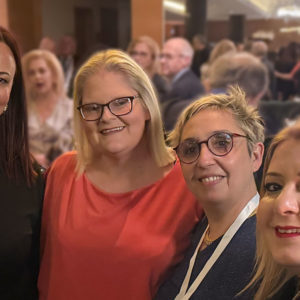In vitro fertilization (IVF), with or without intracytoplasmic sperm injection (ICSI), replicates the first week of embryonic development in a controlled laboratory environment, outside the female reproductive tract (in vitro). This process encompasses the key stages from fertilization to the formation of a blastocyst, just before hatching.
This technique has been in use for over 40 years, dating back to 1978, when Louise Brown, the world’s first IVF-conceived child, was born through the groundbreaking work of Robert Edwards’ team in Great Britain.

Mrs Louise Brown and Dr Olivia Fiori
4th Seminar on Reproductive Medicine,
Athens – March 2025
1. OVARIAN STIMULATION
Unlike ovarian stimulation for intrauterine insemination (IUI), which aims to promote follicular development as close to natural physiology as possible, ovarian stimulation in IVF protocols is designed to induce the simultaneous growth of multiple follicles on each ovary.
To achieve this, higher doses of gonadotropin hormones (FSH)—typically between 150 and 300 IU per day—are administered from the start of the menstrual cycle to stimulate the recruitment of multiple follicles in both ovaries. During this phase, spontaneous ovulation must be prevented by suppressing pituitary activity using either GnRH agonists or antagonists.
Several ovarian stimulation protocols exist for IVF, with variations depending on the approach of each medical team.
For clarity, I have chosen to present the protocols I most frequently use in my current practice.
a. LONG AGONIST Protocol
The long agonist protocol is the oldest IVF stimulation protocol, as GnRH agonists were introduced many years before GnRH antagonists became part of assisted reproduction treatments.
The principle of this protocol is to desensitize the pituitary gland before starting ovarian stimulation through daily injections of GnRH agonists. After approximately ten days, the anterior pituitary gland is put to rest, allowing ovarian stimulation to proceed without the risk of premature ovulation.
In most cases, GnRH agonist injections begin in the second half of the cycle, between days 20 and 23, before ovarian stimulation starts.
At the beginning of the next menstrual cycle, a hormone assay is performed to confirm that the pituitary gland is properly suppressed, and a pelvic ultrasound is used to ensure there are no ovarian cysts. If suppression is confirmed, ovarian stimulation begins with daily gonadotropin injections.
This protocol consists of two phases:
-
- The pituitary desensitization phase, lasting around ten days, during which daily injections of GnRH agonists are administered.
- The ovarian stimulation phase, where gonadotropin injections are introduced while continuing the GnRH agonist injections, leading to two daily injections for about 12 days.
The total treatment duration is approximately three weeks, which is why this is referred to as the “long protocol.
b. SHORT AGONIST Protocol
The short agonist protocol is typically used for patients with low ovarian reserve. This protocol involves low-dose GnRH agonists combined with high-dose gonadotropins to optimize follicular response.
Before starting ovarian stimulation, ovarian suppression is achieved using estrogen-progestin pills. This step helps to synchronize the small follicles, ensuring uniform follicular growth during stimulation.
The total duration of treatment is around twelve days.
c. ANTAGONIST Protocol
The GnRH antagonist protocol was introduced in the late 1990s. Unlike GnRH agonists, antagonists act immediately, achieving pituitary suppression within hours of administration.
In this protocol, ovulation stimulation begins at the start of the menstrual cycle, with GnRH antagonists introduced later, typically around day 6 or 7 of stimulation.
This protocol consists of two phases:
-
- The ovarian stimulation phase, lasting approximately twelve days, with daily gonadotropin injections.
- The pituitary suppression phase, which starts around days 6-7 of stimulation. During this phase, GnRH antagonist injections are added to the ongoing gonadotropin injections, leading to two daily injections for about 5-6 days.
2. TREATMENT MONITORING
Regardless of the stimulation protocol used, monitoring follows the same process, relying on blood tests (measuring estradiol, LH, and progesterone) combined with pelvic ultrasound performed transvaginally with an empty bladder.
During each ultrasound examination, the number and size of developing follicles are assessed. On average, three ultrasounds are performed over a period of approximately 12 days. After each scan, treatment instructions are adjusted accordingly.
3. OVULATION INDUCTION
Ovulation induction allows for the final stages of oocyte maturation, making the eggs fertile and enabling the precise scheduling of oocyte retrieval before ovulation occurs naturally in the pelvic cavity.
In most cases, ovulation is triggered by a subcutaneous injection of recombinant hCG, and oocyte retrieval takes place the following day.
If there is a risk of ovarian hyperstimulation syndrome (OHSS)—indicated by estradiol levels exceeding 4000 pg/ml, the presence of more than 20 follicles, or a history of OHSS—ovulation can instead be triggered using a GnRH agonist injection.
4. OOCYTE COLLECTION – OVARIAN PUNCTURE
Oocyte retrieval is performed before ovulation through a transvaginal ovarian puncture. The procedure takes place in the operating room, under ultrasound guidance, with a brief general anesthesia lasting approximately 10 minutes, without the need for intubation.
The patient receives intravenous fluids and is placed in a gynecological position on the examination table. The bladder is emptied using a urinary catheter. A transvaginal ultrasound probe, equipped with a needle guide, is positioned in the vagina. A fine needle, connected to a continuous suction system, is then inserted through the needle guide. Under ultrasound control, each mature follicle is carefully punctured via the transvaginal route.
The collected follicular fluid is maintained in tubes at a constant temperature of 37°C and immediately sent to the laboratory for examination. Both ovaries are punctured, with only small follicles left untouched.
At the end of the procedure, the operator ensures there is no vaginal bleeding.
The patient is then monitored in the recovery room until she is fully awake.
5. SPERM COLLECTION
On the morning of the ovarian puncture, the partner is required to provide a sperm sample at the medically assisted reproduction (MAP/ART) center. The recommended abstinence period should be no more than 2 to 3 days to optimize sperm quality.
It is mandatory to present proof of identity, as sperm collection cannot proceed without proper identification.
In certain cases, a previously frozen sperm sample stored in the laboratory may be used instead.
6. FERTILIZATION & EMBRYO CULTURE
Once oocyte retrieval is completed, the tubes containing follicular fluid are immediately transferred to the laboratory, where the oocytes are isolated and placed in culture medium droplets.
Fertilization occurs through one of two methods:
-
- In conventional IVF, the oocytes are placed in contact with a prepared sperm sample to allow natural fertilization.
- In ICSI (Intracytoplasmic Sperm Injection), a single sperm is carefully micro-injected directly into each oocyte to facilitate fertilization.
After fertilization, the oocytes are transferred to incubators, where they are closely monitored as they progress through embryonic development.
This short video illustrates the key stages of embryonic development, from Day 3 to Day 5, culminating in the blastocyst stage.Your Content Goes Here
This brief video outlines the key stages of embryonic development between day 3 and day 5, culminating in the blastocyst stage.


